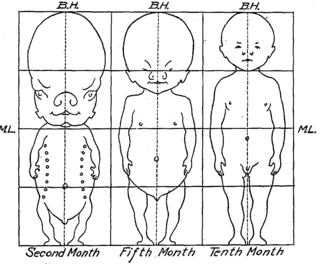

I recently wrote a post on Dinosaur Embryos. One of the more interesting aspects of the find was that differences in relative growth of various body parts turned a quadrapedal infant into a bipedal adult. To understand what is going on here look at the pictures to the left. The first picture shows a baby from the 2nd month after conception to the tenth. The second shows from newborn to adult.
Several things should be noticed about the pictures. First, the diminishing size of the head, relative to the body, in the series. At two months after conception the head is approximately 43% of total body weight. At five months it is 16%. For newborns it is 13%, at five years it is 8%, at ten years it is 6% at 16 years it is 3%. In the meantime, leg length has increased in total percentage of human height. Trunk size (body sans limbs) as also decresed somewhat. Although it is easy to slip into the idea that everything in the body grows at the same rate, this is, in fact, wrong. In humans most of the growth of the brain (and head) happens early in life. Growth in the legs starts later and accelerates till puberty. The same could be said for the arms (although they don't impact height).
That's all fine and good, but what does it have to do with human evolution?
KNM-WT 1500 is a 1.5 million year old Homo erectus skelton - one of the most complete ever found - of an 11-13 year old male.

Among the many studies performed on the skeleton one stands out. Since the skeleton was of a juvenile it was felt that some interesting insights into growth could be gained by comparing the cranium to adult Homo erectus crania. The problem is there are few Homo erectus crania (particularly in the facial region) complete enough for the comparison so a complete female (KNM-ER 3733)was used instead. A series of measurements were taken (using a 3-dimensional digitizer - that's a subject for another post). Basically, the digitizer records cranial landmarks as a set of 3-dimensional distances from each landmark to every other (similar to what Jantz did recently for Kennewick). The measurments were taken on juvenile and adult chimps, juvenile and adult humans (by that I mean H. sapiens) and the female H. erectus skull mentioned above (see Walker and Shipman's "The Wisdom of the Bones" for further info). The goal of the reseaqrch was to determine whether H. erectus had growth patterns like chimps or like humans. Along the way it was found that chimps and humans share a surprisingly similar pattern of growth - which implied that the differences in form between the two were the result of different starting points rather than different patterns of growth. Consequently, H. erectus shared a growth pattern to similar both.
More intriguing is the possibility that this type of analysis could be extended to earlier fossils. Interesting fossils have been found in Drimolen, South Africa (about five years ago). The finds consisted of the bones of two infants. One was 2-3 years of age, the other 8-10 months. One is tentatively assigned to the genus Homo, the other to Australopithecus robustus (the interesting thing about the A. robustus infant was that a lot of the robustus traits were clearly visible on the fragments - indicating that even early in life their are species differences among the australopithecines). Although the finds were fragmentary and only few bits of the crania were found one wonders if in a few years the above type of analysis could be extended to these fossils as well.
Which brings us back to the dinosaur embryos. The lucky preservation of the eggs of Massospondylus carinatus shed some interesting light on how the biped developed and grew from a quadrupedal infant and indirectly on the evolution of the rest of the giant sauropods. More importantly, it was discovered that differences in the growth rates of various body parts of Massospondylus carinatus were responsible.








